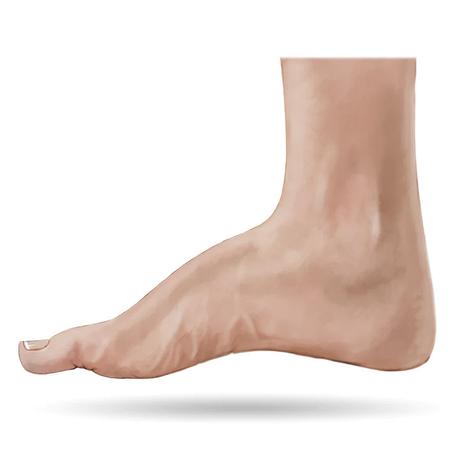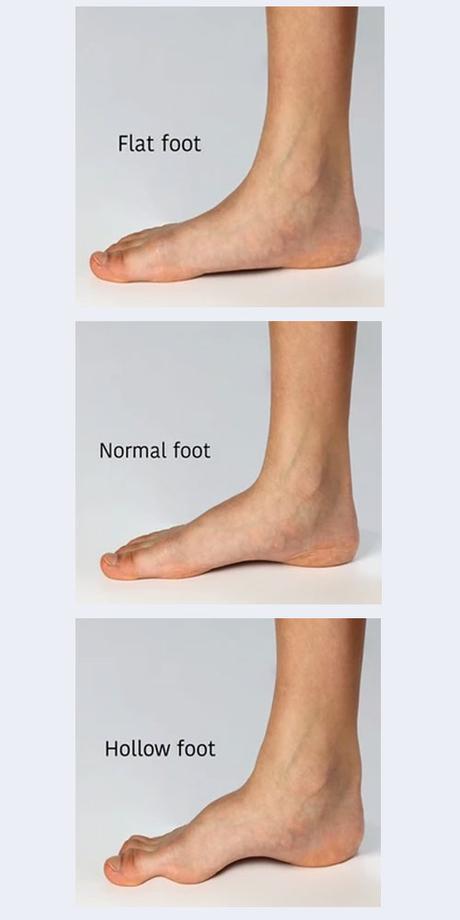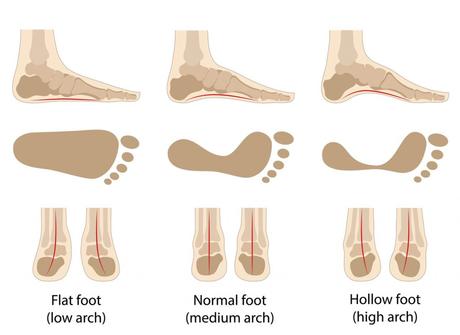Diagnosing and treating deep foot wells and arches.
Pes cavus is a condition in which the arch of the sole is increased more than usual, and the increase of the sole is visible. In general, the inner edge of the foot raises the middle to give the foot an arch-like shape. The height of this arch is different for each person. When walking or standing, too much depression of the foot creates a lot of weight on the ball or heel of the foot, which causes pain and discomfort. The control of severe foot depression and arch depends on the type of disease, the speed of progression, and the severity of the symptoms.

Symptoms of The High Arch of The Foot
When a person with plantar dimpling is standing, the middle of the foot appears to be higher than the normal position. The heel may be drawn to the inner side, and the toes may also be drawn inward. Although the most obvious thing about plantar dimpling is usually the presence of a high arch, this apparent arch is caused by a more fundamental deformity in the foot.
In all feet with potholes, the front of the foot is pulled down more than usual, and the top around the big toe is usually pulled down the most. As a result, the tip of the arch will be up, and the tip of the foot will be on its outer side. This combination creates the appearance of a high arch and
ample space underfoot.
In general, the symptoms of a high arch of the foot are as follows:
- Forked fingers
- Hammer toes (bowed toes)
- Tight Achilles tendon
- Shortening of height/legs
- Difficulty finding the right shoes
- Pain and discomfort in or near the ankle
- Fracture of the metatarsal bone and other bones of the foot
- Instability and frequent ankle sprains
- Pain when walking, running, or even standing
- Dryness in the lower limbs and leg joints (which cause movement disorders)
- Instability of the legs due to the ankle tilting inwards
- Calluses on the sides, heel, and ball of the foot

The Reason for The Dimple and High Arch of The Foot
Most people who struggle with the problem of arches and hollow soles are born with this condition. In other people, there is not much dimple on the sole at birth, and it gradually develops and becomes visible in the first decade of life. The most common causes of severe foot arch are neurological and muscular diseases. However, there are other cases, some of which we will discuss below.
Charcot-Marie-Tooth Disorder
One of the most common causes of deep foot wells is Charcot-Marie-Tooth disorder. In this disease, the development of the nerves, especially those connected to the organs, is not done. Mutated genes cause the body’s inability to produce proteins used in nerves (functional nerve proteins). Loss of proper nerve function can cause the feet to become sensitive, resulting in loss of sensation or ability to move and walk properly. Over time, lack of muscle and inappropriate or insufficient experience in walking will lead to abnormal foot structure.
How to Fix a Pinched Nerve in the Neck? The Best Ways to Get Rid of Your Heel Spurs?Problems and Complications of Cavus foot
- Increasing the arch of the foot can shorten the length of the foot.
- Toes and big toes are deformed into hammer toes.
- The ankle deviates inward, which is called heel varus.
- There is a pain in the leg when standing, walking, and running.
- Leg joints become dry and gradually lose their flexibility.
- Due to excessive pressure, calluses or calluses develop in parts of the foot, especially under the toe.
- Stability is reduced when standing.
- Gradually, the ability to raise the ankle decreases.
Detection of The High Arch of The Foot
If the neurologist suspects the presence of nerve or muscle disease or nerve trauma, she may perform the following tests:
- Electromyography
- MRI of the spine
- Nerve conduction studies
- X-ray test (radiology imaging) of the foot
- X-ray test of the spine

Treatment of High Arch of The Foot
The type of treatment depends on the cause of the pain and the type of arch. For example, if the high angle of the foot is flexible, it may not need any treatment. As a result, to treat severe foot depression, first, a very detailed examination is necessary to rule out the possibility of any neurological disease that causes severe foot depression. However, if you see an increase in foot wells, there are methods to prevent and reduce it, which we will learn about later.
Wear Appropriate Shoes
Wearing suitable shoes with insoles helps in more comfort when walking and reduces pain and discomfort in the feet. A suitable shoe is ideally suited to the foot’s size and has enough space for the toes. If you are walking or doing sports, it is better to use high-top and shock-absorbing shoes. To maintain balance, it is recommended to wear shoes with wide heels. If necessary, consult an orthopedic specialist about suitable shoes or insoles in shoes.
Using Medical Shoe Insoles for Foot Arch
In addition to comfort, using suitable medical insoles also supports the feet. For this purpose, doctors usually prescribe medical insoles for the high arch of the foot to patients, which can be obtained by scanning the sole. These insoles are perfectly sized and suitable for shoes, and their use makes the feet stable and comfortable. Although custom-made insoles are good options, some off-the-shelf insoles are also quite comfortable.
Use of Braces
Braces are incredibly comfortable so patients can use them every day. Ankle braces help keep the joints in a stable position. Wearing braces prevents the ankles from twisting, and by creating balance, they protect the legs and prevent further injuries. Braces are usually prescribed and recommended by doctors to strengthen and protect ankles and feet. The gels that cover the foot’s arch traditionally support the dent, prevent re-injury and control foot drop.
Exercises Suitable for The Arch of The Foot
By performing specific corrective movements for the foot arch, the pain caused by this abnormality can be reduced, and premature disorders can be controlled. We will describe some of these movements below. (It is better to consult your doctor before starting any action.)
Stretching Movement with a Towel
To do this exercise, continue the following steps in order:
- While sitting, stretch your legs fully and wrap a towel around the balls of your feet.
- Bend the leg and pull the towel.
- Repeat the stretching movement of the toes 2 to 5 times.
Squeezing The Toes
To do this exercise, follow the steps below:
- Place your fingers between your toes.
- Press the toes together and keep in this position for at least 10 seconds.
- After a bit of rest, continue this movement again.
Bending The Knee and Doing Stretching Movements with The Help of The Wall
To make this move, continue the following steps in order:
- Stand one foot from the wall and rest your palms on the wall.
- Bend your knees and lean forward slowly. (The soles of the feet must be on the ground.)
- Repeat this exercise several times throughout the day.
Pick Up a Small Ball with your Toes
To do this exercise, follow the steps below:
- With the help of your toes, try to lift a small ball from the ground.
- Throw the ball into the basket.
- If it is difficult to remove the ball, you can use marbles or bath towels.
Surgery to Treat Plantar Arch
In some cases, the sole is so large that surgery may be the only treatment option to reduce the foot arch. Surgery aims to improve function and reduce pain and risks such as leg bone fractures and ankle sprains. According to the nature of the deformity and related problems, surgical methods include tendon transfer, osteotomy, welding, the release of the plantar fascia, and the removal of part of the foot bones. The treatment period for feet well after surgery is usually 6 to 12 months.
Conclusion
The foot’s high arch, like the sole’s flatness, affects the pressure on the lower limbs. People involved with this problem can choose the best way to treat or reduce the stress and damage caused by this problem by visiting a specialist and checking the severity of the sole. Physio 2 Health clinic’s specialized physiotherapy, exercise therapy, and other supportive and therapeutic devices will be with you, dear ones. Contact (905) 392 7000 for a free consultation. Be in touch with us.

